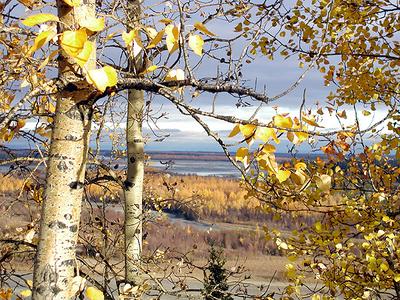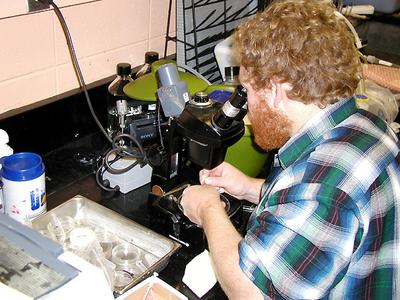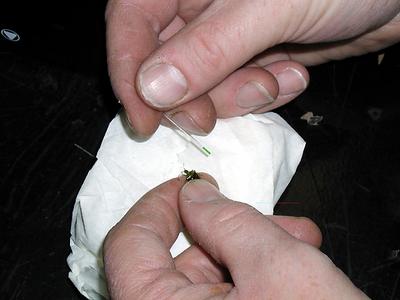20 September, 2002
9/20/02
I am amazed at how easily I can identify Birch Shield Bugs (Stinkbugs) now. Two weeks ago I had never heard of this insect and had certainly never looked for one. Now I walk across an area with leaf litter from Birch trees and I can see Stinkbugs from the corner of my eye. I can look up into a Birch tree and see their silhouette through the golden birch leaf. I do not know what I will ever do with this newly acquired skill, but I will never be able to look at another Birch tree without a subtle look for a Stinkbug. I am also amazed at how tiring a search through trees can be. I have gone to sleep nearly exhausted almost every night, but as I have often heard, there are two kinds of tired and this is definitely a good tired.
Today was another Stinkbug day. As mentioned in an earlier post, Todd Sformo, a PhD student here at the University of Alaska will be spending the next year at Notre Dame learning lab technique for the study of antifreeze proteins in Alaskan Stinkbugs. In order to ensure that Todd has enough Stinkbugs to work with, we need to collect as man as possible right now. The Stinkbug or Birch Shield Bug is a freeze avoiding species that winters in the leaf litter on the forest floor. In spring, the Stinkbug crawls back up into the Birch tree where it spends spring and summer. The cycle is complete when the bug falls from the tree back into the leaf litter in the fall. We spent almost two full days in the Wiseman area, picking through leaf litter to find 70-80 Stinkbugs. On our first day of collecting in the Fairbanks area, we collected nearly 1000 stinkbugs in a single day. The difference here is that the Fairbanks Stinkbug population is still in the trees. It is much easier to find these little green and red bugs when they are against the yellow-gold background of a fall Birch leaf. In fact, we believe that we just happened to get to Fairbanks for the last few days that the bugs still reside in the trees for the year. We had our first heavy frost last night and with a light wind, many of the Birch trees have lost their leaves. Our much smaller number of Stinkbugs collected today (about 150) tells us that the Stinkbugs have followed the leaves to the ground. Our task for the next several days will be to find areas where the Birch trees still have leaves and still have Stinkbugs.
Since Stinkbugs are so much easier to find when still in the trees, Todd and I will head to areas south of Fairbanks over the next few days to see if we can find some places where the Birches are still full. We will also be searching for signs of an insect known as the Spruce Bark Beetle. The Spruce Bark Beetle is an insect that has always been known in Alaska, but increased greatly in population and has made a significant move northward with the warming temperatures in Alaska over the last few years. These beetles can be very destructive on stands of Spruce trees and are therefore a serious concern for the Alaskan ecosystem. No one is quite sure just how far north the beetles have come, but it is suspected that they may be north of the Alaskan Range Mountains by now.
The Spruce Bark Beetle is approximately 5-6 centimeters in length making it approximately the same size as the Click Beetles we were finding on the tundra. The Bark Beetles normally live only in downed trees but when their population expands too quickly, they begin to infest healthy standing trees. In healthy trees, they bore through the interior and eventually kill the tree. Alaskan officials believe this beetle to be a very significant threat to Alaskan forests.
Our interest in the Spruce Bark Beetle would be to determine its methods for surviving winters and potentially use information to halt the spread of the beetle. If, for example, the beetle was found to have a very specific antifreeze protein or other antifreeze chemicals allowing it to survive during winter, we might be able to find a method to alter the beetles’ ability to survive. Without winter survival the beetle problem could be addressed.

Birch trees like this one house our Stinkbugs. Some of the trees have the added attraction of a nice view. The area behind the tree is river valley where Fairbanks is located.

Sometimes we find other insects in our search foe Stinkbugs. This was the first pink Ladybug I had ever seen.

Once we have collected the Stinkbugs, we get samples of hemolymph (blood). We must get samples from smaller insects under the microscope.

Stinkbugs have a deep green hemolymph. Very different from the clear hemolymph we were getting from beetles
Contact the TEA in the field at
.
If you cannot connect through your browser, copy the
TEA's e-mail address in the "To:" line of
your favorite e-mail package.
|
